
Assembling the Rajkumar oil expeller
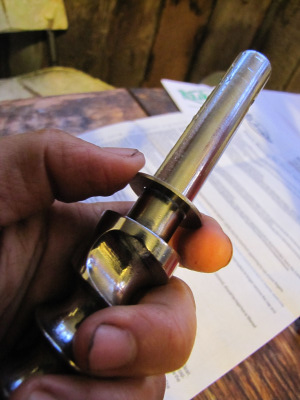 The
assembly instructions that came with our Rajkumar oil expeller left a
lot to be desired, but I figured it out pretty easily by looking at the
picture below, snagged from their website.
The
assembly instructions that came with our Rajkumar oil expeller left a
lot to be desired, but I figured it out pretty easily by looking at the
picture below, snagged from their website.
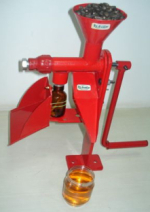
To be fair, it's
possible that the hand-lettered CD that came with the expeller might
have included more pictorial instructions, but I couldn't open the
files on my computer. In case you follow my lead and buy the
Rajkumar expeller, I've included step by step assembly instructions
below.
Your expeller will come
partially assembled, but you have to remove the expeller screw and wash
it, along with the rest of the expeller, prior to the first use.
Once the parts are 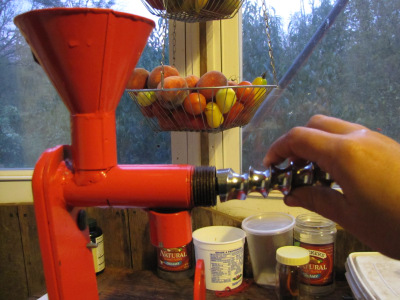 clean
and dry, slip one of the two included washers over the handle end of
the expeller screw and grease it with cooking oil, as shown above on
the right. The instructions note "This washer is exposed to very
high pressure and should always be well greased."
clean
and dry, slip one of the two included washers over the handle end of
the expeller screw and grease it with cooking oil, as shown above on
the right. The instructions note "This washer is exposed to very
high pressure and should always be well greased."
Next, slide the expeller
screw into the press cage (the main part of the expeller) until the
smooth end pops out the other side.
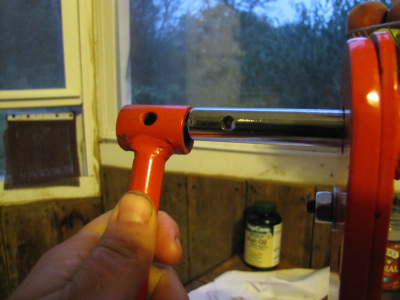 The
handle slides right over the end of the expeller screw --- just be sure
to line up the holes. The longest bolt in the kit seems to be the
only one that fits to put these two parts together.
The
handle slides right over the end of the expeller screw --- just be sure
to line up the holes. The longest bolt in the kit seems to be the
only one that fits to put these two parts together.
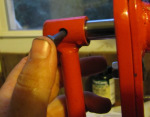
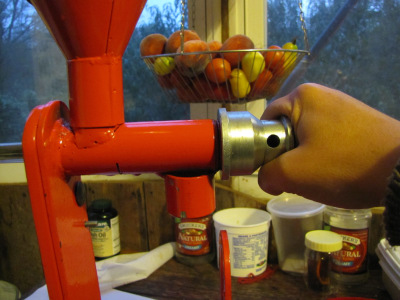 The
cap screws easily onto the other end of the press cage. Depending
on the type of seed you will be processing, you may also need to screw
the adjustment bolt into the cap. We left the bolt off since
we'll be expelling sunflower seeds first.
The
cap screws easily onto the other end of the press cage. Depending
on the type of seed you will be processing, you may also need to screw
the adjustment bolt into the cap. We left the bolt off since
we'll be expelling sunflower seeds first.
Those of you following
along at home may have realized by now that, up until this point, the
Rajkumar expeller is completely identical to the Piteba model, except
for the bigger stand bolted to the back. A 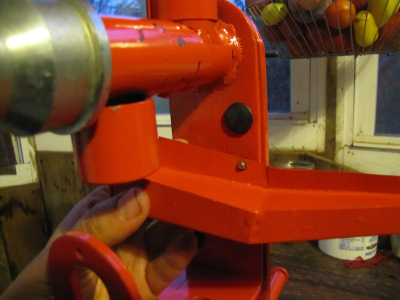 close
look at both websites makes me pretty sure that the two brands are in
fact identical, but that the Rajkumar expeller has added in the bigger
stand and three handy funnels. These funnels are made of much
less strong material than the angle iron and heavy pipes that make up
the main body of the expeller, but I'm sure they will hold up well
under the light use they'll be put to.
close
look at both websites makes me pretty sure that the two brands are in
fact identical, but that the Rajkumar expeller has added in the bigger
stand and three handy funnels. These funnels are made of much
less strong material than the angle iron and heavy pipes that make up
the main body of the expeller, but I'm sure they will hold up well
under the light use they'll be put to.
The longest funnel
(shown above) is meant to channel the oil away from the expeller so
that you can collect your product in a larger jar than you could with
the Piteba expeller. The oil funnel is attached with a single
screw threaded through the back of the expeller.
 If
you're smarter than I was, you'll rubber-band your bottle of lamp oil
to the rounded part of the expeller before moving on to the next step,
but I didn't have any lamp oil on hand, so I went ahead and screwed the
seed cake funnel to the front of the expeller with the other small
screw. I'll have to remove this funnel and attach the "lamp"
before operating the expeller.
If
you're smarter than I was, you'll rubber-band your bottle of lamp oil
to the rounded part of the expeller before moving on to the next step,
but I didn't have any lamp oil on hand, so I went ahead and screwed the
seed cake funnel to the front of the expeller with the other small
screw. I'll have to remove this funnel and attach the "lamp"
before operating the expeller.
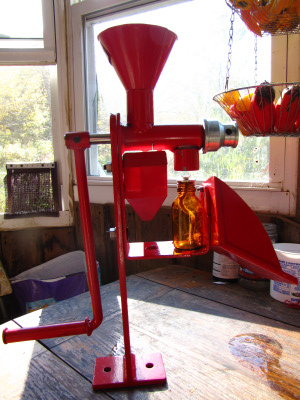 To complete assembly of the oil expeller, I
popped the round funnel on the top, having to bend the base a bit so
that it slid on smoothly. This last photo shows the completely
assembled expeller, with the lamp bottle in place to show its location.
To complete assembly of the oil expeller, I
popped the round funnel on the top, having to bend the base a bit so
that it slid on smoothly. This last photo shows the completely
assembled expeller, with the lamp bottle in place to show its location.
Despite this long post,
assembling the Rajkumar oil expeller only took about 15 minutes, and
that includes a bit of head-scratching. The kit came with
absolutely everything you might need, too, including a tiny screwdriver
and wrench. I would say that assembly is within the reach of even
the beginner DIYer.
Want more in-depth information? Browse through our books.
Or explore more posts by date or by subject.
About us: Anna Hess and Mark Hamilton spent over a decade living self-sufficiently in the mountains of Virginia before moving north to start over from scratch in the foothills of Ohio. They've experimented with permaculture, no-till gardening, trailersteading, home-based microbusinesses and much more, writing about their adventures in both blogs and books.
Want to be notified when new comments are posted on this page? Click on the RSS button after you add a comment to subscribe to the comment feed, or simply check the box beside "email replies to me" while writing your comment.

I've got this oil lamp that used to run on kerosene / lamp oil. I stopped using it indoors because of the strong smell. Hopefully your sunflower seed oil doesn't come out tasting like kerosene! I'm searching for a wick that works properly with olive oil, but haven't found it yet.
Be careful with the expeller screw. It looks like it is the hardest to make and most expensive part of the whole device. I expect it to be designed so that the bolt locking the handle to the screw shears off before the screw itself comes to harm if you overstress it. Don't be tempted to replace the bolt with a higher grade one or fit a bigger handle.
Is there a small radius where the thin part of the screw meets the thick part? (where you put the washer on) If not, that is a place where it could to break because of stress concentration. Additionally I don't think you should lean on the lever because that would impart a bending moment as well as a torque on the axis.
I'll definitely just do a short test run with the kerosene --- if it gives any flavor to the oil, that's a deal breaker. I have read that the impurities in kerosene make it smoke more, so I might have to hunt down some real lamp oil.
Thanks for those tips about the expeller screw! It shoulds like I'll have to be very careful. Mark was talking about maybe trying to hook an electric motor up to it to crank out more oil if we ever need a bigger quantity, but that might be a bad idea given what you've said.
I'm not sure I quite understand what you're asking when you ask "Is there a small radius where the thin part of the screw meets the thick part?" What do you mean by a small radius?
Standard simple design practice would be to take the maximum expected static load, multiply that by three, and design so that all parts just can handle that load. I do not know what the maximum resistance of the nuts in the screw would be, but IMO the worst case would be a jammed screw where you would have a person leaning with his full weight on the handle which would be in a horizontal position. So a cautious designer would design for three times that load, people being what they are. Now I haven't done the math, but it doesn't look that sturdy to me. But I could be wrong.
OTOH, they could have sized the bolt that connects the handle end to the handle to shear off before the expensive screw can be damaged. That's what us engineers call a controlled failure mode.
You could put on a electric motor drive, but you'd have to think that through. If the motor can generate much more torque and power than a human (which most easily can) you could break the expeller. Or the motor, depending on which type you'd use.
Where the face on the screw that the lubricated washer sits on (your top-right picture) meets the handle end of the screw, there should be a small fillet between the face and the handle end.
The reason for that is found in solid mechanics. When you are turning the screw you are applying both a torque and a bending moment to the handle end. Now for both torque and bending loads, the stresses that these cause in the material of the screw are greatest at the surface of the material. Now where the handle end meets the thicker part of the screw, the stresses "flow" from the handle end into the thick part. Because these stresses have to go around a corner, they tend to concentrate themselves. And the sharper the corner, the bigger the concentration. If the concentrated stres becomes higher than the proportional limit of the steel it will yield. Wether that results in a bent shaft or a broken one depends on the kind of steel used and the treatment it has had.
So the fillet serves to reduce stress concentrations.
Normally food processing equipment is made exlusively from stainless steel since it is corrosion resistent and has antibacterial properties. The screw looks like it might be stainless, but it might also be simply chrome plated. The rest of the machine probably isn't since it has been painted, and the tread on the end of the press cage looks like an oxidised brown color in your pictures.
IIRC, vegetable oils are made up of weak acids, which might corrode the non-stainless parts of the machine over time even though it will not rust because of the oil. I'm curious as to how the oil will taste and how the machine will hold up.
I was looking into purchasing 1 maybe 2 of these expellers and I was just wondering how yours is holding up and if you have been happy with it
thanks for your help
Tammy --- I'm ashamed to say, we've only used it a few times. We were very unhappy with the smoky result from using kerosene to heat the expeller. Since we don't have a source for quality (ie non-smoky) lamp oil locally, Mark has tried some electric heating options, but no good results yet.
Keep in mind this is all due to us not following manufacturer's instructions, though! If you have a place to buy lamp oil near you, you might have better results.
you can also order the oil on Ace Hardware's website and have it shipped to your home pretty reasonable.
Remember to go through shop at home to earn a percentage back on your purchase http://www.shopathome.com/?IAFCG=3+9+LgkohiLau+7LiJiS+w==
I was hoping that you have gotten your ultra pure smokeless lamp oil from amazon and hooked up a motor. It's fun to see the guys running their cars on this biodiesel, power to the mighty plants!
first off, I agree that European standards are more to my liking. Besides that, I am very aware that piteba is the guy who developed the idea. He is kind enough to share it with those who need it. I am sure that I want to support him and I believe that he is the one who evolves this project.
I am interested in putting a motor on mine. I could also put a bicycle sprocket on it and get some exercise!
Mark, before you retire this project, try the black sesame oil. Oh man. I love it so much that I want to just live on it, why not do that easily?
I would love any help you might offer about motorizing it. I am using a bicycle chain drive and a treadmill motor but I haven't gotten it together yet
Using Oil Expellers Manufactured by Gobind Expeller Company. Quite easy to install and good performance.